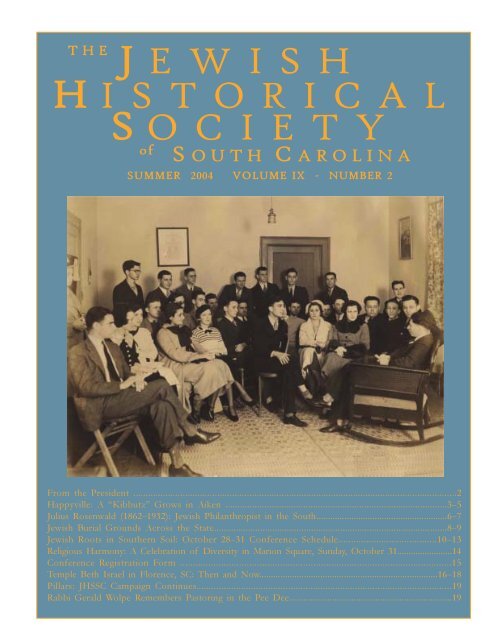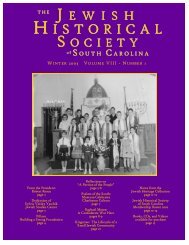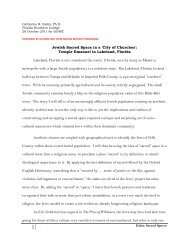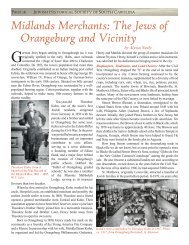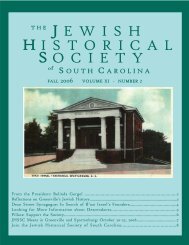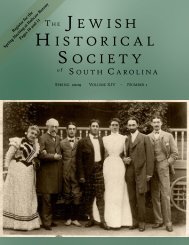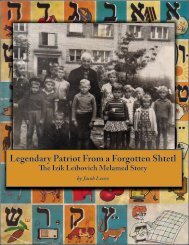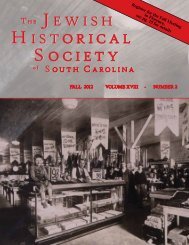summer 2004 newsletter - Jewish Historical Society of South Carolina
summer 2004 newsletter - Jewish Historical Society of South Carolina
summer 2004 newsletter - Jewish Historical Society of South Carolina
You also want an ePaper? Increase the reach of your titles
YUMPU automatically turns print PDFs into web optimized ePapers that Google loves.
PAGE 4JEWISH HISTORICAL SOCIETY OF SOUTH CAROLINAMorris Rothman,Oakland, California, 1915“We went to court about it. The judge says tome, ‘You know what happens to little boys who tell lies?’I said, ‘Yes, they go to hell. The devil gets them.’” YoungAl testified and the judge awarded my grandfather sixdollars—one for each pig. “We won!” my aunt chortledat age 100. “We won!”Amazingly, they did. On the word <strong>of</strong> a child. Thechild <strong>of</strong> <strong>Jewish</strong> outsiders and socialists. Did the neighborscheer, or did they resent it? The Aiken library held no clue.What I did find was: “Aiken Colony Is a Success,” AikenJournal, August 13, 1907. “Happyville colony isremarkable. . . .” Notices proudly invited the public topatronize the new cotton gin and saw mill.A year later, it was over.Ida’s explanation: “My father worked dawn todusk behind a plow. He wanted to prove they couldmake a go <strong>of</strong> it. The others dressed up and went to town.It made him so mad.”Shankman blames bad weather, internal dissension,lack <strong>of</strong> skills, poor soil, debt. And he says that intellectuals,Al Rothman in his World War Iarmy uniform, 1919.Rothman served in France.Ida (Arline) Rothman Knowltonand her mother Bertha Rothman,Oakland, California, 1937who staged Yiddish plays and had Tolstoy in their library,“would have longed for a richer cultural and social life.” 5Nowhere did I read that treating blacks as equals led to aboycott <strong>of</strong> the colony’s goods. But then, no colonists wereinterviewed—none stayed to tell the tale.Happyville didn’t last long, but “failure” seems thewrong word.1Interview <strong>of</strong> Al Rothman, 1982, recorded by CarolMorrison, daughter <strong>of</strong> Al’s sister, Sara RothmanRosenblatt.2Ida (Arline) Knowlton (1902–2003).3Arnold Shankman, “Happyville, the Forgotten Colony,”American <strong>Jewish</strong> Archives 30 (April 1978): 3–19.4Author <strong>of</strong> From Selma to Sorrow, The Life and Death<strong>of</strong> Viola Liuzzo (Athens: University <strong>of</strong> Georgia Press,1998).5Shankman, 19.At the Russiancolony in Aiken
SUMMER <strong>2004</strong> VOLUME IX - NUMBER 2PAGE 5A Brief History <strong>of</strong> the ColonyIn December 1905, ten families <strong>of</strong> Russian-<strong>Jewish</strong>immigrants left New York City’s tenements to settle anagricultural colony near the village <strong>of</strong> Montmorenci in AikenCounty. They were answering an invitation published by<strong>South</strong> <strong>Carolina</strong>’s Department <strong>of</strong> Agriculture, Commerce andImmigration and translated into Yiddish, to come and buy“very fertile land” to be had “very cheaply.” Desperate forworkers to till large tracts <strong>of</strong> land abandoned during the CivilWar, state <strong>of</strong>ficials decided that industrious EasternEuropeans would save its economy. The immigrants calledthe colony Happyville. It lasted less than three years.E. J. Watson, a Columbia newspaperman active inthe Chamber <strong>of</strong> Commerce, was hired to oversee theprogram. In New York, he enlisted Charles Weintraub, anidealist who had been a piano tuner in Russia. Weintraubwas all enthusiasm. He purchased a 2,200-acre tract, sevenmiles from Aiken, forming the Incorporative FarmingAssociation, and sold shares to his friends—socialists andintellectuals like himself. The land was poor, mostly forest,but had a stream, livestock, farm implements, and a fewbuildings. Soon the colonists were felling trees for lumberand making plans for a cotton gin and sawmill. More peoplecame, eventually totaling around 50.The weather the first year was terrible. A latefrost damaged the cotton plants; heavy rains destroyedthem. But the colonists’ spirits were good. The secondyear, the weather cooperated and they were prospering.A school for their children opened. The public wasinvited to patronize their new ginnery and sawmill,powered by a 36-inch turbine using stream water. Thesmall <strong>Jewish</strong> community in Aiken welcomed thecolonists in spite <strong>of</strong> political and religious differences.The local paper pronounced Happyville an unqualifiedsuccess.But by the middle <strong>of</strong> 1908, it was over. Manyproblems contributed: another harsh winter, heavy debt,lack <strong>of</strong> farming knowledge, internal dissension, and lack<strong>of</strong> patronage for their gin and mill. A rival ginnery wasbeing built by nearby farmers. The colony auctioned <strong>of</strong>fits land and equipment. The colonists—who had losttheir money and hopes—left. Happyville was gone,leaving no trace.Photo credits: Portraits courtesy <strong>of</strong> Marcia Savin.Landscape scenes courtesy <strong>of</strong> Winthrop UniversityArchives.Scene at the Aiken colonyMarcia Savin is an author and playwright. Her children’sbook, The Moon Bridge (Scholastic) deals with the challenge<strong>of</strong> prejudice to a friendship <strong>of</strong> two fifth-graders, oneJapanese-American, during World War II. It is used inschools throughout the country. She lives in Brooklyn,New York. Anyone with information about Happyville,please contact Marcia at msavin2@earthlink.net or718.852.2867.Coming in October…Published by the College <strong>of</strong> CharlestonLibrary in association with Brith SholomBeth Israel. Signed copies will be availableat the “<strong>Jewish</strong> Roots in <strong>South</strong>ern Soil”conference.
PAGE 6JEWISH HISTORICAL SOCIETY OF SOUTH CAROLINAJulius Rosenwald(1862-1932)<strong>Jewish</strong> Philanthropist in the <strong>South</strong>by Doris BaumgartenAs the nation celebrates the 50th anniversary <strong>of</strong>Brown vs. Board <strong>of</strong> Education, the landmark SupremeCourt decision that overturned school segregation inAmerica, it may be difficult to imagine just how dismalthe prospects were for African-American children, at theheight <strong>of</strong> the Jim Crow era, to get an education. In therural <strong>South</strong> conditions were particularly bleak.An important force for change came from anunlikely source. Chicago-born philanthropist JuliusRosenwald allied himself with Tuskegee Institute’sBooker T. Washington for the purpose <strong>of</strong> buildingschools and libraries for black students across theregion. Son <strong>of</strong> German-<strong>Jewish</strong> immigrant parents,Rosenwald made his fortune as C.E.O. <strong>of</strong> Sears,Roebuck, and Company. Between 1917 and 1932, theRosenwald Foundation provided seed-money for morethan 5,300 schools in 15 states, including 500 in <strong>South</strong><strong>Carolina</strong>. By 1928, one in every five schools for ruralblack children was a Rosenwald School, educating onethird<strong>of</strong> the school-age population.Rosenwald not only contributed financially butalso concerned himself with the construction details. Hewanted the best designs for natural lighting andventilation. Health and hygiene were not overlooked andplans included specifications for wells and privies.Rosenwald felt strongly that the success <strong>of</strong> theschools depended on local involvement. Communitieswere required to share the costs <strong>of</strong> construction andequipment, as well as upkeep and maintenance <strong>of</strong> thebuildings. Cost-sharing could be monetary, in-kind, or“sweat-equity”—that is, contributions <strong>of</strong> labor. Thefoundation’s seed-money amounted to as little as onefifth<strong>of</strong> the total cost; the rest came from local schoolboards, businesses, and residents, white and black.Oak Grove SchoolOAK GROVE SCHOOL built in 1924 on four acres <strong>of</strong> land as aone-teacher school.Total cost $1,670Contributions: Negroes $70Public $1,200Rosenwald $400None <strong>of</strong> these three Rosenwald Schools built in AikenCounty, <strong>South</strong> <strong>Carolina</strong>, is still standingSchool photographs courtesy <strong>of</strong> the Fisk UniversityArchives. Portrait from the Dictionary <strong>of</strong> AmericanPortraits (Dover Publications, 1958). Map courtesy <strong>of</strong>Tom Hanchett.
SUMMER <strong>2004</strong> VOLUME IX - NUMBER 2PAGE 7Seivern SchoolSEIVERN SCHOOL built in 1923-24 on four acres as a twoteacherschool.Total cost $2,708Contributions: Negroes $1,142Public $66Rosenwald $800Raised in Springfield, Illinois, young Julius hadjoined the fledgling Chicago concern named Sears,Roebuck and Company in 1897. Capitalizing on the RuralFree Delivery system instituted the following year by theU.S. Post Office, he helped Sears become the world’slargest retailer with the publication <strong>of</strong> the “Wish Book”distributed to thousands <strong>of</strong> rural households. Through thisthick, enticing catalog, anyone could order householdgoods and farm supplies, from clothing to canningequipment, medical supplies to tractor parts, seeds,chickens, and even an entire build-it-yourself house.Rosenwald credited Chicago’s SinaiCongregation, which he attended as a youth, for instillingin him the <strong>Jewish</strong> values <strong>of</strong> Tzedakah and Tikkun Olam.He supported many <strong>Jewish</strong> and non-<strong>Jewish</strong> causes,including the Federation <strong>of</strong> <strong>Jewish</strong> Charities, HullHouse, and the Museum <strong>of</strong> Science and Industry inChicago, Hebrew Union College in Cincinnati, the<strong>Jewish</strong> Theological Seminary in New York City, andblack YMCAs and YWCAs in cities across the country.REFERENCESPeter Ascoli. Address given to <strong>South</strong> <strong>Carolina</strong> Preservation<strong>Society</strong>, Columbia, S.C., April 10, 2003.Fisk University Archives, Nashville, Tennessee.Mary S. H<strong>of</strong>fschwelle, Preserving Rosenwald Schools(Washington D.C.: National Trust for Historic Preservation,n.d.).Allen Riddick, Aiken County Schools (Aiken, S.C.: RocketPublishers, <strong>2004</strong>).Website: www.rosenwaldplans.orgAiken Graded SchoolAIKEN GRADED SCHOOL built under the 1924-25 budgetand outfitted for nine teachers.Total cost $33,500Contributions: Negroes $3,500Whites $1,500Public $27,000Rosenwald $1,500According to grandson and biographer Dr.Peter Ascoli, Rosenwald’s <strong>Jewish</strong> heritage gave him aparticular affinity with African Americans. “The horrorsthat are due to race prejudice,” Rosenwald wrote in1911, “come home to the Jew more forcefully than toothers <strong>of</strong> the white race, on account <strong>of</strong> the centuries <strong>of</strong>persecution which they have suffered and still suffer.”The philanthropist refused to allow his name tobe used on any <strong>of</strong> the schools he helped bring intobeing, preferring that their names reflect communitypride. Poignantly, most <strong>of</strong> the remaining schools,whether abandoned or converted to other uses, todayare referred to as “Rosenwald Schools” by people livingnearby.ADDITIONAL SOURCESJames Anderson, The Education <strong>of</strong> Blacks in the <strong>South</strong>,1860–1935 (Chapel Hill: University <strong>of</strong> North <strong>Carolina</strong> Press,1988).Edwin Embree and Julia Waxman, Investment in People: TheStory <strong>of</strong> the Julius Rosenwald Fund (New York: Harper andBrothers, 1949).Adam Fairclough, Teaching Equality: Black Schools in theAge <strong>of</strong> Jim Crow (Athens: University <strong>of</strong> Georgia, 2001).Thomas W. Hanchett, “The Rosenwald Schools and BlackEducation in North <strong>Carolina</strong>,” North <strong>Carolina</strong> <strong>Historical</strong>Review LXV: 4 (October 1988).Louis Harlan, Separate and Unequal: Public SchoolCampaigns and Racism in the <strong>South</strong> States, 1901–1915(Chapel Hill: University <strong>of</strong> North <strong>Carolina</strong> Press, 1958).Alicestyne Turley-Adams, Rosenwald Schools in Kentucky,1917–1932 (Frankfort: Kentucky Heritage Council and theKentucky African American Heritage Commission, 1997).
PAGE 8JEWISH HISTORICAL SOCIETY OF SOUTH CAROLINA<strong>Jewish</strong> Burial GroundsAcross the State by Stanley FarbsteinOver one hundred years ago, Rabbi BarnettElzas <strong>of</strong> KKBE in Charleston began a survey <strong>of</strong> <strong>Jewish</strong>burial grounds across the state. This work continued forover a decade and resulted in surveys <strong>of</strong> cemeteries inCamden, Charleston, Columbia, Georgetown,Orangeburg, and Sumter. These books are not justsimple lists <strong>of</strong> who was buried where and when, butalso provide information about the deceased, includingfamily, places <strong>of</strong> origin, occupations, and honors. Nowlargely unavailable except in archives, Elzas’ bookscontinue to serve as a valuable source on <strong>Jewish</strong> life in<strong>South</strong> <strong>Carolina</strong> in the 18th and 19th centuries.Unfortunately, this survey by Rabbi Elzas wasthe last comprehensive survey <strong>of</strong> <strong>Jewish</strong> cemeteries in<strong>South</strong> <strong>Carolina</strong>. Now, a hundred years later and in the350th year <strong>of</strong> <strong>Jewish</strong> settlement in the United States, the<strong>Jewish</strong> <strong>Historical</strong> <strong>Society</strong> <strong>of</strong> <strong>South</strong> <strong>Carolina</strong> (JHSSC),as a part <strong>of</strong> its mission to collect and record the <strong>Jewish</strong>history <strong>of</strong> the state, has undertaken to survey <strong>Jewish</strong>cemeteries, including the burial grounds <strong>of</strong> some <strong>South</strong><strong>Carolina</strong> Jews in Savannah and Augusta, Georgia.Bernard Warshaw, president <strong>of</strong> the JHSSC, has askedthat I plan and organize this survey. A number <strong>of</strong>individuals have already agreed to participate in theproject. (See “List <strong>of</strong> Local Contacts.”)This cemetery project <strong>of</strong> the JHSSC is not asimple effort. A lot <strong>of</strong> work is required and completionis projected to take at least three years. To date, <strong>Jewish</strong>cemeteries have been identified in 14 locales across thestate: Aiken, Anderson, Beaufort, Camden, Charleston,Columbia, Florence, Georgetown, Greenville, HiltonHead Island, Orangeburg, Spartanburg, Sumter, andWalterboro. Columbia and Charleston have multiplecemeteries. There are a reported 13 <strong>Jewish</strong> burialgrounds in Charleston, including two now covered withasphalt.There may be other <strong>Jewish</strong> cemeteries in thestate that should be surveyed. Suggested possibleadditional sites are Darlington, Lancaster, and MyrtleBeach.Beth Israel Cemetery, Beaufort, SCPhotos by Paul Keyserling.The survey <strong>of</strong> each cemetery will be a separateeffort, planned and conducted by local residents, and theresult at each location will be published in a report for thatarea.Copies will be distributed locally and placed invarious archives in the state. Work is already underway andtwo <strong>of</strong> the reports should be issued late this year.Volunteers are needed to help to organize and carryout this project. It <strong>of</strong>fers the opportunity for involvement incommunity service by local youth groups, confirmationclasses, students at colleges and universities, and retirees.When the project is completed, we expect the JHSSC tocompile and publish the results.Those interested in participating should contact :Stanley Farbstein14 Lockwood Drive, Apt 11HCharleston, SC 29401phone: 843.722.6608e-mail at stan-farb@worldnet.att.net.Please help us with this important project.
SUMMER <strong>2004</strong> VOLUME IX - NUMBER 2PAGE 9A Search for InformationA survey <strong>of</strong> the Beth Israel Cemetery in Beaufort has beenunderway for about 18 months, and the report is now indraft form and being edited. There have been 156 burials inthe cemetery with the earliest in 1912.Obituaries and biographical information on over 85 percent<strong>of</strong> those buried in the cemetery have been located.However, little or no data has yet been found for the otherburials. If you have information on any <strong>of</strong> these five,including where they were when they died, please contactStanley Farbstein.Betty Donen (date <strong>of</strong> birth unknown, died 6/1/1953):Widow <strong>of</strong> Isaac Donen who died in 1914. A son orgrandson, Stanley Donen, once lived in Columbia andlater in Hollywood and directed the movie, “Singing inthe Rain.”Meir Jaffa (1866–1923): Mr. Jaffa was awarded a PhD.He is reported to have lived at Dale, and been agenius.Phillip “Uncle Phil” Kohn (1870–1943) and Anna Kohn(1867–1943): It is believed that they had no childrenand had a store on Bladen Street near Bay.Tessie Reinstein Weinberg (1878–1963): Wife <strong>of</strong> JosephWeinberg; a native <strong>of</strong> Ridgeland.Also, we are trying to learn more about Rabbi Jacob Silber(1845–1933) and his family who came to Beaufort fromRussia in the last quarter <strong>of</strong> the 19th century. Rabbi Silberserved until at least 1911 in Beaufort and severalsurrounding towns. His family included his wife Esther(1856–1933), daughter Rose (1890–1975), sons Mendel(or Mendall) and Raphael, both <strong>of</strong> whom, by 1911, wererabbis in other American cities. Daughter Rose married MaxCitron <strong>of</strong> Columbia in Beaufort in 1911.List <strong>of</strong> Local ContactsSo far our cemetery project has recruited the followingvolunteers:Aiken: Doris BaumgartenAnderson: Mike KrupsawBeaufort: Stanley FarbsteinCharleston: Sol Breibart and Ruth JacobsColumbia: Bernard “Nard” FleishmanJoe and Nancy LiptonGreenville: H. J. “Hy” BrandHilton Head: Paul IsaacOrangeburg: Rhetta MendelsohnSumter: Robert and Clara Keilwert MosesWalterboro: Bernard Warshaw
PAGE 10JEWISH HISTORICAL SOCIETY OF SOUTH CAROLINA<strong>Jewish</strong> Roots in <strong>South</strong>ern Soil:THURSDAY, OCTOBER 288:00 AM - 9:00 PM REGISTRATION at Sylvia Vlosky Yaschik <strong>Jewish</strong> Studies Center96 Wentworth Street (JSC)8:00 AM - 6:00 PM All day bus tour <strong>of</strong> Savannah, Georgia (pre-registration required)6:00 PM JHSSC Board Meeting at JSC, Arnold HallSJHS Board Meeting at JSC, Library, Room 2097:00 PM Reception at the Historic Mordecai/Prenner House(JHSSC Board Members and invited guests)7:30 PM <strong>Jewish</strong> Film Program at the JSC, Arnold HallFRIDAY, OCTOBER 298:00 AM - 9:00 PM REGISTRATION at Sylvia Vlosky Yaschik <strong>Jewish</strong> Studies Center9:00 AM - 10:45 AM Bus Tour <strong>of</strong> Charleston <strong>Jewish</strong> Sites (pre-registration required)10:00 - 11:00 AM JHSSC Membership Business Meeting at JSC, Arnold Hall11:00 AM - 12:45 PM Bus Tour <strong>of</strong> Charleston <strong>Jewish</strong> Sites (pre-registration required)12:00 PM Lunch on your own12:00 PM SJHS Membership Meeting at KKBE meeting room, 90 Hasell Street.ALL AFTERNOON EVENTS TAKE PLACE AT Kahal Kadosh Beth Elohim90 Hasell Street (between Meeting and King)1:00 PM Welcome: <strong>Society</strong> Presidents and Special Guests1:30 PM Keynote Address: Hasia Diner (New York University),“Wandering Jews, Peddlers, Immigrants, and the Exploration <strong>of</strong>New Worlds”Generously supported by Bornblum Judaic Studies Program, University <strong>of</strong> Memphis2:30 PM Concurrent Panel Discussions:Panel APanel BBending Boundaries: <strong>South</strong>ern <strong>Jewish</strong> WomenKarla Goldman, <strong>Jewish</strong> Women’s Archives, Chair/CommentLinda Borish (Western Michigan University), “<strong>Jewish</strong> Women, Athletics, and SocialChange in <strong>South</strong>ern <strong>Jewish</strong> History and American Culture”Hollace Weiner (University <strong>of</strong> Texas at Arlington; Research Fellow, <strong>Jewish</strong> Women’sArchives), “The <strong>Jewish</strong> Junior League: The Council <strong>of</strong> <strong>Jewish</strong> Women, Springboard toSecular Status in Fort Worth”Judith Shanks (Independent scholar; Associate Curator, “A Portion <strong>of</strong> the People”),“Stitching Together an Ordinary Life: Rebecca Isaiah Moses (1792–1872) <strong>of</strong>Charleston”Fiction as History/History as FictionPhyllis Leffler (University <strong>of</strong> Virginia), ChairRoy H<strong>of</strong>fman, Mobile Register, author <strong>of</strong> Almost Family and Chicken Dreaming CornJudy Goldman, author <strong>of</strong> The Slow Way Back and Early Leaving4:00 PM Tour <strong>of</strong> Special Collections at the new Marlene and Nathan Addlestone Library,College <strong>of</strong> Charleston, with Dale Rosengarten, Curator, <strong>Jewish</strong> Heritage Collection6:00 PM SJHS Dinner in Alumni Hall, Randolph Hall, College <strong>of</strong> Charleston (behind the Cistern)6:00 PM Shabbat Evening at Local Synagogues: BSBI, KKBE, and Emanu-El in West Ashley7:30 PM Keynote Address at KKBE: Gary P. Zola (Hebrew Union College/American <strong>Jewish</strong> Archives), “What Have We Wrought?: Reflectionson 350 Years <strong>of</strong> American <strong>Jewish</strong> History”
SUMMER <strong>2004</strong> VOLUME IX - NUMBER 2Charleston, SC - October 28-31, <strong>2004</strong>PAGE 11SATURDAY, OCTOBER 308:00 AM - 9:00 PM REGISTRATION at Sylvia Vlosky Yaschik <strong>Jewish</strong> Studies CenterALL MORNING & AFTERNOON EVENTS TAKE PLACE AT Kahal Kadosh Beth Elohim8:00 AM Continental Breakfast9:00 AM Concurrent Panel Discussions:Panel A <strong>Jewish</strong>/Christian EncountersScott Langston (<strong>South</strong>west Baptist University), ChairGeorge R. Wilkes (Cambridge University), “Renewing the Study <strong>of</strong><strong>South</strong>ern <strong>Jewish</strong>-Christian Relations: The Private Diary <strong>of</strong> Rabbi David Marx”Lawrence G. Charap (University <strong>of</strong> Rhode Island), “‘A Spiritual Gulf’: Rev. CharlesA. Allen and <strong>Jewish</strong>-Christian Dialogue in Turn-<strong>of</strong>-the-Century New Orleans”Natalie Ornish (Independent Scholar), “Rabbi Henry Cohen <strong>of</strong> Galveston”Ellen Umansky (Fairfield University), CommentPanel BThe How-Tos <strong>of</strong> Oral History ProjectsDale Rosengarten (College <strong>of</strong> Charleston) andMarcie Cohen Ferris (University <strong>of</strong> North <strong>Carolina</strong>, Chapel Hill), Co-ChairsMary Lynn Mansbach (<strong>Jewish</strong> <strong>Historical</strong> <strong>Society</strong> <strong>of</strong> Memphis and the Mid-<strong>South</strong>)Alan Stein (New Orleans Public Library)Jayne Guberman (<strong>Jewish</strong> Women’s Archives)Sponsored by the SJHS State and Local <strong>Historical</strong> Liaison Committee10:30 AM Panel <strong>Jewish</strong> GeographyDavid Goldfield (University <strong>of</strong> North <strong>Carolina</strong>, Charlotte; editor, Journal <strong>of</strong> UrbanHistory), Chair/CommentStephen Whitfield (Brandeis University), “Is Florida Part <strong>of</strong> <strong>South</strong>ern <strong>Jewish</strong>History?”Elliot Ashkenazi (Independent Scholar), “<strong>Jewish</strong> Bankers/Financiers and FamilyTies Across National and International Boundaries, 1870–1915”12:15 PM Luncheon - Jerome M. Gumenick Keynote Lecture: Marc Lee Raphael,College <strong>of</strong> William and MaryIntroduction by Lee Shai Weissbach (University <strong>of</strong> Louisville)Generously supported by Jerome M. Gumenick Family Foundation2:15 PM Walking Tour <strong>of</strong> <strong>Jewish</strong> Sites (pre-registration required)continued on next page
PAGE 12JEWISH HISTORICAL SOCIETY OF SOUTH CAROLINAJoint Conference: SJHS and JHSSCSATURDAY, OCTOBER 30 continued ..............................ALL AFTERNOON EVENTS TAKE PLACE AT Kahal Kadosh Beth Elohim2:15 PM Panel <strong>Jewish</strong> “Racial” Identities in the Urban Pre-Industrial <strong>South</strong>Leonard Rog<strong>of</strong>f (<strong>Jewish</strong> <strong>Historical</strong> Foundation <strong>of</strong> NC), Chair/CommentHolly Snyder (Brown University), “Jews and the Race Question in Early Savannah,1733-1831”Gemma Romain (National Archives, Surrey, U.K.), “Race, Ethnicity and Whiteness:Constructions <strong>of</strong> Identity within the Diaries <strong>of</strong> the Antebellum Community <strong>of</strong>Charleston”Stephen Brown (Albany [NY] Academy for Girls), “The Lynching <strong>of</strong> Leo Frank:Defining the ‘Racial’ Jew in the American <strong>South</strong>, 1913–1915”3:45 PM Panel The Conservative Movement in Charleston and the <strong>South</strong>Eric Goldstein (Emory University), Chair/CommentDavid Starr (Hebrew College, Boston), “Solomon Schecter and theConservative Movement in the <strong>South</strong>”Peggy Pearlstein (Library <strong>of</strong> Congress), “With an Eye Toward Zion:Macey Kronsberg and the Origins <strong>of</strong> Charleston’s Conservative SynagogueEmanu-El and Zionism”5:00 PM Dinner on your ownALL EVENING EVENTS TAKE PLACE AT Brith Sholom Beth Israel182 Rutledge Avenue (between Radcliffe and Morris)8:15 PM Lama Lo! Concert9:45 PM Dessert ReceptionSynagogue Emanu-ElKahal KadoshBeth ElohimBrith Sholom Beth IsraelSylvia Vlosky Yaschik<strong>Jewish</strong> Studies Center
SUMMER <strong>2004</strong> VOLUME IX - NUMBER 2PAGE 13SUNDAY, OCTOBER 318:00 AM - 3:00 PM INFORMATION at Sylvia Vlosky Yaschik <strong>Jewish</strong> Studies CenterALL MORNING EVENTS TAKE PLACE AT Brith Sholom Beth Israel9:00 AM Meet The AuthorsRonald Bayor (Georgia Institute <strong>of</strong> Technology; editor, Journal <strong>of</strong> AmericanEthnic History), ChairAlan Kraut (American University), “Goldberger’s War: The Life and Times <strong>of</strong> aPublic Health Crusader”Ray Mohl (University <strong>of</strong> Alabama, Birmingham), “<strong>South</strong> <strong>of</strong> the <strong>South</strong>: <strong>Jewish</strong>Activists and the Civil Rights Movement in Miami, 1945–1960”Co-sponsored by the American Immigrant and Ethnic <strong>Historical</strong> <strong>Society</strong>10:00 AM Brunch11:30 AM Keynote Address: Jeffrey S. Gurock (Yeshiva University),“A Commentary on a Synagogue History: Brith SholomBeth Israel and American <strong>Jewish</strong> History”Introduced by David Patterson (University <strong>of</strong> Memphis)Generously supported by Bornblum Judaic Studies Program, University <strong>of</strong> Memphis12:45 PM 150th AnniversaryRededication <strong>of</strong> BSBI1:30 PM - 5:00 PM The celebration movesto the center <strong>of</strong> Charleston.Join us for the festivities in MarionSquare Park.RELIGIOUS HARMONY:A CELEBRATION OF DIVERSITYSee bottom <strong>of</strong> page 14for more information.7:30 PM Rabbi Gerald I. Wolpe will speak at Synagogue Emanu-ElThe famed Rabbi Gerald Wolpe <strong>of</strong> Philadelphia will <strong>of</strong>fer his thoughts onStephen Fried’s page-turner, The New Rabbi. Rabbi Wolpe plays a starringrole in this book that has taken the Conservative rabbinate by storm.Keynote SpeakersHasia DinerFriday, October 291:30 pmGary P. ZolaFriday, October 297:30 pmMarc Lee RaphaelSaturday, October 301:00 pmJeffrey S. GurockSunday, October 3111:30 am
PAGE 14JEWISH HISTORICAL SOCIETY OF SOUTH CAROLINACharleston boasts one <strong>of</strong> the oldest <strong>Jewish</strong> communitiesin America. Just 40 years after a boatload <strong>of</strong> refugees fromRecife, Brazil, sailed into the port <strong>of</strong> New Amsterdam, Jewsbegan making their presence felt in the young colony <strong>of</strong> <strong>Carolina</strong>.In 1697, four <strong>Jewish</strong> men secured the rights <strong>of</strong> citizenship; in1749, Charles Town’s Jews founded Kahal Kadosh Beth Elohim;and by 1800, the port city counted more Jews than any placeelse in the United States.This landmark conference commemorates both the 350thanniversary <strong>of</strong> <strong>Jewish</strong> settlement in America, and the 150thanniversary <strong>of</strong> Charleston’s Orthodox congregation Brith SholomBeth Israel. The weekend also marks the 10th anniversary <strong>of</strong> thefounding <strong>of</strong> the <strong>Jewish</strong> <strong>Historical</strong> <strong>Society</strong> <strong>of</strong> <strong>South</strong> <strong>Carolina</strong>. The<strong>South</strong>ern <strong>Jewish</strong> <strong>Historical</strong> <strong>Society</strong> and JHSSC have put togetheran extraordinary array <strong>of</strong> scholarly and social events. Charlestonis proud <strong>of</strong> the close working relationship among its synagoguesand rabbis. KKBE, BSBI, and Emanu-El are all participating inthe programs. Offerings include tours <strong>of</strong> Charleston andSavannah, lectures and panel discussions featuring prominentscholars, Shabbat services, book signings, and a gala musicalconcert. The weekend will conclude on Sunday with a rededication<strong>of</strong> BSBI, and a community block party at Marion Square.RELIGIOUS HARMONYA CELEBRATION OF DIVERSITYmarion square parksunday, october 31, <strong>2004</strong>1:30 - 5:00pmfree and open to the publicFEATURING:LAMA LO!, THE COLLEGE OF CHARLESTONGOSPEL CHOIR, NA FIDLIERI,JEWISH CHORAL SOCIETY, CHARLESTONCHILDREN’S CHORUS, ARTS AND CRAFTS,FOOD VENDORS, CHILDREN’S ACTIVITIESAND MUCH MORE.CO-SPONSORED BY THE CITY OF CHARLESTONAND THE YASCHIK/ARNOLD JEWISH STUDIES PROGRAM AT THE COLLEGE OF CHARLESTONARTWORK COURTESY OF BEA AARONSON
SUMMER <strong>2004</strong> VOLUME IX - NUMBER 2PAGE 15JOINT CONFERENCE: SJHS AND JHSSCOCTOBER 28-31, <strong>2004</strong>CHARLESTON, SOUTH CAROLINAREGISTRATION FORMREGISTRATION DEADLINE IS SEPTEMBER 15, <strong>2004</strong>.Last Name ___________________________ First ________________________Spouse/Friend ____________________________________________________Address _________________________________________________________City ___________________________ State________________ Zip _________Phone () ____________________ E-mail ___________________________I request meals that are: [ ] Vegetarian [ ] Strictly Kosher.Name(s) on name tags ______________________________________________I WISH TO MAKE RESERVATIONS FOR THE FOLLOWING:(fees are per person; advance reservations are mandatory)Thursday, Savannah, Georgia Tour with lunch $ 96 _______________Friday, Charleston Bus Tour 9:00 AM $ 10 _______________Friday, Charleston Bus Tour 11:00 AM $ 10 _______________Saturday, Charleston Walking Tour $ 5 _______________Friday Shabbat evening activities (no additional charge):BSBI services & dinnerKKBE musical service & onegEmanu-El dinner (transportation provided)SJHS dinner at Randolph Hall, C<strong>of</strong>C (prior to KKBE service)Registration fee: current JHSSC/SJHS member (circle one) $ 150 _______________per personAdditional fee for non-members (per family) $ 35 _______________SPECIAL PACKAGE - BSBI ONLY $ 125 _______________LATE REGISTRATION FEE (after 9/15/04) $ 25 _______________MAKE CHECK PAYABLE TO:QUESTIONS:JHSSCEnid Idelsohn<strong>Jewish</strong> Studies Center 843-953-3918College <strong>of</strong> CharlestonIdelsohnE@c<strong>of</strong>c.eduCharleston, SC 29424www.c<strong>of</strong>c.edu/~jwst
PAGE 16JEWISH HISTORICAL SOCIETY OF SOUTH CAROLINATemple Beth Israel –Then and Now by Beatrice K. Rogol“To unite the Hebrews <strong>of</strong> Florence andsurrounding country into a fraternal and benevolentassociation and to assist needy Israelites.”“The purchasing and maintaining <strong>of</strong> asuitable burying ground.”These were the two objectives <strong>of</strong> the FlorenceHebrew Benevolent Association, stated in theorganization’s constitution and by-laws in 1887. Todaythe fraternal and benevolent association continues underthe name Beth Israel Congregation. The methods <strong>of</strong>operating may be different, but the intended purposes <strong>of</strong>the original constitution remain the same.Situated in the Pee Dee region <strong>of</strong> <strong>South</strong><strong>Carolina</strong>, Florence has seen great change over the past117 years. As the city grew, so did the <strong>Jewish</strong> population– from the Lyons and Jacobi families, who were theearliest known <strong>Jewish</strong> settlers in town, arriving before1865, to a total <strong>of</strong> approximately 70 families living inFlorence and surrounding towns today.Travelers to the city a century ago could find acomfortable bed and a hearty welcome at the Jacobihouse, which was a well-known hotel located on what isnow Front Street. In 1881, the only <strong>Jewish</strong> children inFlorence were those <strong>of</strong> Mr. and Mrs. A. A. Cohen, Beaand Edna. To receive a <strong>Jewish</strong> education, they traveledto Darlington, where worship services also were held.As more <strong>Jewish</strong> families settled in Florence,the need arose to reach out. So, on October 26, 1887,D. Sternberger, J. Dejongh, S. Elias, and Harris Josephapplied for a charter for a charitable and religiousassociation to be known as The Florence HebrewBenevolent Association, with a capital <strong>of</strong> 25 shares at$10.00 each, for the purpose <strong>of</strong> “creating andmaintaining an Israelites’ burial ground, and for educationand religious purposes.” Leadership was provided byChairman D. Sternberger, Secretary-Treasurer J.Dejongh, and Director E. Salmonsen.A cemetery lot was soon purchased for $50.00from the Northeast Railroad. In the tradition <strong>of</strong> his father,Charles Insel, Secretary-Treasurer, Herman InselGroundbreaking for addition to Temple Beth Israel,Florence, SC, February, 1969. Left to right: Herb Levy,Nat Rosenfeld, Ray Wolpert, Herman Insel, Arthur Siegal,Rabbi Charles Lesser, Eric Heiden.Photo courtesy <strong>of</strong> Lois & Ray Wolpert.scrupulously maintained the records <strong>of</strong> the cemetery.After Herman Insel’s death in 1999, Mark Schemel tookover the task <strong>of</strong> record keeping.On June 2, 1889, A. A. Cohen made a motionto “order Sunday School books, that a Sunday School beestablished and all children <strong>of</strong> Israelite parents, who wereor were not members <strong>of</strong> this association, were cordiallyinvited to send their children to participate in the exercise<strong>of</strong> the Sunday School lessons and that also the parents beinvited to attend.” That was the beginning <strong>of</strong> a religiousschool that continues today, providing for more than ahundred years the Judaic foundation for our area youngpeople.A Certificate <strong>of</strong> Incorporation was filed with theState <strong>of</strong> <strong>South</strong> <strong>Carolina</strong> on September 27, 1912,establishing a congregation to be known as Beth Israel,with B. Patz, M. Rosenfeld, and I. Silverman signing astrustees.During the years 1906 to 1922, a small number<strong>of</strong> Orthodox Jews found their way to Florence. They heldservices, conducted by Rabbi Silver, in various placesaround the city. Then, sometime around 1922, acompromise was reached between the Orthodox Jews<strong>of</strong> Florence and those who chose to follow ReformJudaism.
SUMMER <strong>2004</strong> VOLUME IX - NUMBER 2The two groups decided to hold Reform servicesand Sunday School classes monthly, and Orthodoxservices on the High Holy Days. The latter took place inthe homes <strong>of</strong> Orthodox Jews <strong>of</strong> the community and wereconducted by lay leaders, including Louis Greenberg, father<strong>of</strong> Dr. S. A. Greenberg. Rabbi Jacob Raisin <strong>of</strong> KahalKadosh Beth Elohim in Charleston was hired to conductReform services in various halls, beginning over what wasthen Zeigler’s Drug Store, better known as the store on thecorner <strong>of</strong> Dargan and Evans streets. Rabbi Raisin remaineda spiritual leader <strong>of</strong> Beth Israel for 25 years. Sam andHannah Semless <strong>of</strong> Philadelphia, grandparents <strong>of</strong> NathanielRosenfeld, donated the first Torah in honor <strong>of</strong> Nat’sparents, Maurice and Mae Rosenfeld.Around 1927, congregants decided to build asynagogue. Land on East Elm Street was purchased forthat purpose, but was subsequently sold to the city for theerection <strong>of</strong> Florence High School. In the meantime, Reformservices continued in the Rainwater Building, moved to theYMCA before World War II, then to the Masonic Temple,and finally, in 1947, returned to the YMCA. During theseitinerant years, the president’s car trunk served as storagespace for prayer books and the Torah.PAGE 17Religious school, 1971. Left to right: Sheryl Fram,Bari Heiden, and Beth Sopkin. Photo courtesy <strong>of</strong> Beth Israel.Religious services in the new building continuedon a monthly basis, led by rabbis from Sumter andColumbia, <strong>South</strong> <strong>Carolina</strong>, and from Charlotte. At thattime, Beth Israel’s 25 families could not afford to hire afull-time rabbi. However, in 1953, with more <strong>Jewish</strong>families moving into the area, Rabbi Fabian came toserve as the congregation’s first full-time spiritualleader.Rabbi Fabian helped reorganize the Sundayschool and began conducting weekly services onFriday nights. Rabbi Morris Clarke followed, bringingmusic to the congregation. Rabbi Avery Grossfieldcame next, introducing Hebrew into the Sunday schooland holding adult education classes. He performed thefirst bar mitzvah services in the Temple. When RabbiGrossfield left, student rabbis Jay Krouse and thenPaul Kushner from the seminary in New York beganmaking the trip to Florence every two weeks forweekend services, Sunday school, and Hebrewclasses. Next came Rabbi Gottesman, a circuit-ridingrabbi who traveled in a bus outfitted as a mobile shul.He served until 1961, when Rabbi Charles B. Lesserarrived and stayed until 1970.Junior choir with Rabbi Avery Grossfield, 1956.Photo courtesy <strong>of</strong> Beth Israel.In February 1949, congregants began discussingconstruction <strong>of</strong> a new religious facility on land located onPark Avenue, donated by Dr. Michael M. Morse. Dr. S. A.Greenberg, Dr. Morse, and Isadore Stein were appointedto a committee to manage construction. The Union <strong>of</strong>American Hebrew Congregations provided building plansand the facility was completed in July 1949. In SeptemberRabbi Philip Frankel <strong>of</strong> Charlotte, North <strong>Carolina</strong>, presidedover a formal dedication.Plaque commemorating addition and renovation<strong>of</strong> Temple Beth Israel, 1969. Photo courtesy <strong>of</strong> Beth Israel.
PAGE 18JEWISH HISTORICAL SOCIETY OF SOUTH CAROLINAConfirmation, 1974. Left to right: PatriceHorinbein, Bonnie Sopkin, David Lovit, RabbiHoward Folb, Cathy Cohen, Marcy Wolpert, andAnn Radin.The congregation continued to grow, and duringRabbi Lesser’s tenure, made plans for expansion. In1967, Beth Israel bought two houses close to the Templeand a year later undertook to remodel the originalbuilding, adding a kitchen, classrooms, and social hall.The houses were demolished and a building committeewas appointed, consisting <strong>of</strong> Chairman Dr. Eric Heiden,Nathaniel Rosenfeld, Dr. S. A. Greenberg, Herman Insel,and Dr. Raphael Wolpert, who also served as chairman<strong>of</strong> the Future Expansion Fund. Spring 1969 saw agroundbreaking ceremony, and the building wascompleted in June 1970. The congregation’s new rabbi,Howard Folb, was present for the dedication ceremony.and led High Holy Day services in the new structure.Rabbi Folb remained for about 11 years,followed by Rabbi Sidney Strome, who served fiveyears. Rabbi Lawrence N. Mahrer replaced Strome andstayed for ten years, succeeded by Rabbi Marc Kline.Rabbi Kline left in 2003, after which a student rabbi,Malcom Cohen, was hired on a part-time basis.In 1986, Temple Beth Israel underwent anotherchange. With Dr. Eric Heiden spearheading a committeemade up <strong>of</strong> Dr. S. A. Greenberg, Ruth Greenberg,Herman Insel, Dr. Raphael Wolpert, Melvin Siegel,Patricia Siegel, Sandra S. Levy, Selig Levine, and RabbiLawrence Mahrer, the sanctuary was renovated and thepulpit remodeled.During these years <strong>of</strong> growth and expansion,Temple Beth Israel’s Sisterhood and Men’s Clubcame into their own. The Sisterhood’s precursor,known as the Beth Israel Ladies Aid <strong>Society</strong>, began in1922. Concerned with Sunday school and communityactivities, the 13 original members served as a nucleus.Mrs. Abraham Schafer, elected as the first president <strong>of</strong> thenew Sisterhood in 1928, saw to it that the <strong>Society</strong> becameaffiliated with the National Federation <strong>of</strong> TempleSisterhoods. Monthly meetings were held in members’homes until 1949, when the group moved to the newTemple Assembly Room, presided over by Mrs. ChesterHeimlich.Sometime around 1958, the Men’s Club wasestablished with Marvin Fine as president. The clubaffiliated with the National Federation <strong>of</strong> Brotherhoodsand, like Sisterhood, became a vital fund-raising arm <strong>of</strong>the Temple, as well as organizing social activities for themen <strong>of</strong> the congregation.In 1973, because the work <strong>of</strong> Sisterhood and theMen’s Club overlapped, the decision was made to mergethe two organizations, and The Affiliates was born. Whileeach group kept its own identity with the two NationalFederations, members <strong>of</strong> The Affiliates shared equally inits leadership and work, alternating between a male andfemale president and vice president. Frederick Levyserved the first presidential term, and Patricia Lovit thesecond. Beth Israel’s Affiliates was a pioneer in the merger<strong>of</strong> Sisterhoods and Mens Club—indeed it was the firstorganization <strong>of</strong> its kind in the nation. At a convention inSavannah, Georgia, circa 1975, the two presidentsreported on its success. Today, The Affiliates continues toraise funds and sponsor social activities.In recent years, Temple Beth Israel was thebeneficiary <strong>of</strong> two significant mergers. The Darlingtoncongregation, whose membership was slowly diminishing,decided to join Beth Israel. Then, in 2000, Dillon’s OhavShalom, whose numbers also were declining, decided tounite with Beth Israel. This merger took place during thetenure <strong>of</strong> Rabbi Marc Kline. With the incorporation <strong>of</strong> thetwo nearby congregations, Beth Israel’s membership grewto 100 family units, and many committed and activepeople came under the Temple’s umbrella.Today, the congregation draws from Florence,Darlington, Marion, Dillon, Kingstree, and Murrells Inlet,<strong>South</strong> <strong>Carolina</strong>, and Laurinburg, North <strong>Carolina</strong>. Theexpanded religious school is turning out young people witha well-rounded <strong>Jewish</strong> education. A choir enhancesservices. The Affiliates is a mainstay <strong>of</strong> the Temple. A fullservicehouse <strong>of</strong> worship has become the center forJudaism in the Florence area.
SUMMER <strong>2004</strong> VOLUME IX - NUMBER 2Pillars:Our Campaign ContinuesPillars are the backbone <strong>of</strong> the <strong>Jewish</strong><strong>Historical</strong> <strong>Society</strong> <strong>of</strong> <strong>South</strong> <strong>Carolina</strong>. Our pillars fundall the operational costs <strong>of</strong> the <strong>Society</strong>, except forprinting and mailing expenses, which are covered bymembership dues. Pillars also provide essentialsupplemental funds for the <strong>Jewish</strong> Heritage Collection,the ongoing research archives at the College <strong>of</strong>Charleston Library.Pillars commit $1000 a year for five years.Membership to the JHSSC is included in the gift.Please join this distinguished list. (Parenthesesindicate the year in which donations began.)See membership form on the back page.John and Marcie Baker, Columbia, SC (2003)Norman and Eve Berlinsky, Charleston, SC (<strong>2004</strong>)Alan Coleman, Charleston, SC (2003)Richard and Belinda Gergel, Columbia, SC (2002)Mark and Judith Green, Charleston, SC (2002)Ruth Greenberg, Florence, SC (2002)Michael Kogan, Little Falls, NJ (2002)* Ronald and Anne Krancer, Villanova, PA (2002)Rabbi Ted and Ina Rae Levy, Hilton Head, SC (2002)Susan Lourie, Columbia, SC (<strong>2004</strong>)Jack and Frieda Margolies, Charleston, SC (2002)Rose Mark, Beaufort, SC (2002)Albert and Robin Mercer, Owensboro, KY (2003)Lee and Karen Ortner , Charleston, SC (<strong>2004</strong>)Susan Pearlstine, Park City, UT (2003)Benedict and Brenda Rosen, Myrtle Beach, SC (2003)Robert and Susan Rosen, Charleston, SC (2002)Jeffrey and Mickey Rosenblum, Charleston, SC (2002)Paul and Jayne Siegel, Walterboro, SC (2003)Steve and Harriett Steinert, Sullivan’s Island, SC (2002)Gordan and Barbara Stine, Charleston, SC (2002)Mark Tanenbaum, Sullivan’s Island, SC (2002)Bernard and Ann Warshaw, Walterboro, SC (2002)Jerry and Anita Zucker, Charleston, SC (<strong>2004</strong>)* Anne Krancer, a devoted member <strong>of</strong> JHSSC andan original pillar <strong>of</strong> the <strong>Society</strong>, passed away inApril. She will be sorely missed. May her memorybe a blessing.Additonal photography by E. B. Heston, DaleRosengarten, and Gordon H. Scheck Jr. Postcardimages from the collections <strong>of</strong> Rabbi William A.Rosenthall and Leah D. Greenberg. Thanks toRost Beyder, Rachel Garrett, Marwa Shideed,Andrew Woods, and especially Dale Rosengarten,for their help.PAGE 19Rabbi Wolpe RemembersPastoring in the Pee Dee--from a letter by Rabbi Gerald I. Wolpe to JHSSC, April 14, 2003.“I received the Winter 2003 Newsletter <strong>of</strong> the<strong>Historical</strong> <strong>Society</strong>. All <strong>of</strong> it was very interesting but I wasparticularly intrigued with the Kingstree story. I was theConservative rabbi mentioned in the article. Once a month,Cantor Renzer and I would travel over 300 miles. First wewould go to Kingstree where the congregation consisted <strong>of</strong>people from Kingstree and Lake City. The visit wouldconsist <strong>of</strong> a class with children and then a short service foradults and children. Then he and I would go on to Dillonand Myrtle Beach where the same program took place.We returned late at night, exhausted but with a feeling <strong>of</strong>great satisfaction.There were so many wonderful stories thataccompanied the tour. I found it fascinating to see howNorthern Jews – who came to the area during WWII –adapted to their new surroundings. Some assimilated to thedegree that their <strong>South</strong>ern accent was more extreme thanthe natives. Others hated every moment and yearned fortheir return to the shtetls <strong>of</strong> Baltimore and New York.I became the rabbi <strong>of</strong> the area and was called formany secular communal events. That put me in touch withthe non-<strong>Jewish</strong> community. It was the volatile period <strong>of</strong> thedesegregation battle and I had to walk a narrow path whenspeaking to Lake City Kiwanis or Dillon Lions. It was atrying but meaningful period <strong>of</strong> reaching out to so manywho were in the midst <strong>of</strong> possible violence. One week, forexample, there was the shooting <strong>of</strong> a Black minister in LakeCity for his activism. The tension was brutal and I waswarned to skip the visit that month.I remember meeting a man who was an <strong>of</strong>ficial <strong>of</strong>the <strong>Carolina</strong> Baptist Church. He was a sophisticatedurbane physician who showed me his impressive library.He showed me a collection <strong>of</strong> Mahzorim and the sermons<strong>of</strong> Isaac Leeser. His ancestress’ name was in it. He was abachelor and he asked for the name <strong>of</strong> a <strong>Jewish</strong> institutionto which he could give them. I suggested the SeminaryLibrary and he sent them there. He gave me the Leeserbooks, which I still cherish.”Rabbi Gerald Wolpe and his wife, Elaine, will return toCharleston in October. Emanu-El discovered Rabbi Wolpe longbefore he became nationally known as rabbi at Har Zion inPhiladelphia and the “hero” <strong>of</strong> Stephen Fried’s just publishedThe New Rabbi. Emanu-El’s conference weekend begins witha Shabbat dinner on Friday, October 29 at 6:00 pm, andconcludes with Rabbi Wolpe’s reflections on Fried’s book onSunday, October 31 at 7:30 pm.
PAGE 20JEWISH HISTORICAL SOCIETY OF SOUTH CAROLINAYaschik/Arnold <strong>Jewish</strong> Studies ProgramCollege <strong>of</strong> CharlestonCharleston, SC 29424phone: 843.953.3918fax: 843.953.7624website: www.c<strong>of</strong>c.edu/~jwst/pages/jhssc.htmle-mail: jhssc@c<strong>of</strong>c.eduNON-PROFITU.S. POSTAGEP - A - I - DCHARLESTON, SCPERMIT No. 437Martin Perlmutter, Executive DirectorEnid Idelsohn, AdministratorOfficersBernard Warshaw, PresidentBelinda Gergel, Vice-PresidentEdward Poliak<strong>of</strong>f, Second Vice-PresidentDavid J. Cohen, TreasurerArline Polinsky, SecretaryPast PresidentsIsadore Lourie, o.b.m.Founding PresidentRichard GergelKlyde RobinsonRobert RosenJeffrey RosenblumBoard <strong>of</strong> DirectorsIrving Abrams, GreenvilleGerry Sue Arnold, ColumbiaDoris Baumgarten, AikenEve Berlinsky, CharlestonMoss Blachman, ColumbiaJack Bloom, GreenvilleH.J. Brand, GreenvilleSol Breibart, CharlestonLeah Chase, CharlestonRobert Dreyfus, GreenvilleStanley Farbstein, CharlestonCarolee Rosen Fox, CharlestonBen Goldberg, CharlestonLeah Greenberg, Sullivan’s IslandLyssa Harvey, ColumbiaRuth Jacobs, CharlestonAlan Kahn, ColumbiaHarriet Keyserling, BeaufortMichael Kogan, CharlestonHarold Kornblut, LattaMike Krupsaw, AndersonTheodore Levy, Hilton HeadMick Lourie, ColumbiaJane Mendelsohn, CharlestonElizabeth Moses, GeorgetownI. Harby Moses, SumterRobert Moses, SumterHerb Novit, Hilton HeadKaren Ortner, CharlestonMickey Rosenblum, CharlestonSandra Rosenblum, CharlestonJulian Schoenberg, GreenvilleRobert Seigel, CharlestonHarriett Steinert, Sullivan’s IslandBarbara Stender, CharlestonDesign and Layout by Enid IdelsohnName:Address:City: State: Zip:Phone: ( ) Fax: ( )E-mail Address:Please join the <strong>Jewish</strong> <strong>Historical</strong> <strong>Society</strong> <strong>of</strong> <strong>South</strong> <strong>Carolina</strong>.Fill out this form and return it to:JHSSC, <strong>Jewish</strong> Studies ProgramCollege <strong>of</strong> Charleston, Charleston, SC 29424Please make checks payable to JHSSCANNUAL DUES FOR <strong>2004</strong>(MEMBERSHIP RUNS ON A CALENDAR YEAR, JANUARY-DECEMBER)Individual/Family Membership $36Friend $200Sponsor $350Founding Patron $1000Pillar$5000 ($1000 for five years)<strong>2004</strong> GIFT MEMBERSHIPS AVAILABLEEnroll your friends and relatives for an additional $36 each.Please provide their information and we will inform them <strong>of</strong> your gift.


